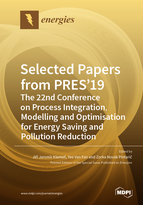Selected Papers from PRES’19: The 22nd Conference on Process Integration, Modelling and Optimisation for Energy Saving and Pollution Reduction
A special issue of Energies (ISSN 1996-1073). This special issue belongs to the section "B: Energy and Environment".
Deadline for manuscript submissions: closed (29 February 2020) | Viewed by 80783
Special Issue Editors
Interests: process; heat; power and water integration; environmental footprints; sustainable development; circular economy
Special Issues, Collections and Topics in MDPI journals
Interests: solid waste management; waste treatment and recovery; scenario analysis; cleaner production; organic waste; environment footprint
Special Issues, Collections and Topics in MDPI journals
Interests: process engineering; process simulation; chemical processes; wastewater treatment; process optimization; process modeling; process development; modeling and simulation; sensitivity analysis; simulation; industrial process; process design; chemical process design; HYSYS; thermal and energy integration of processes; processes economics; risk and uncertainty in investment decision making
Special Issues, Collections and Topics in MDPI journals
Special Issue Information
Dear Colleagues,
Energy use and emissions should be accompanied by measures for their reduction. This is the focus of the series of conferences, PRES (Conference on Process Integration for Energy Saving and Pollution Reduction)—a major annual forum dedicated to the exchange of knowledge and networking. The 22nd conference (PRES’19) was organised in Crete, Greece 20–23 October 2019. The conference targeted a wide range of topics related to energy supply, conversion and use, for improvement of the efficiency and sustainability of the concerned activities. Some of the topics included:
- Process integration for sustainable development;
- Process analysis, modelling and optimisation;
- Total site integration;
- Heat transfer and heat exchangers;
- Energy-saving and clean technologies;
- Sustainable processing and production;
- Renewable and high-efficiency utility systems;
- Footprint minimisation and mitigation;
- Operations and supply chain management;
- Numerical fluid flow and heat transfer simulation;
- Work and heat exchanger networks;
- Gas turbines and turbomachinery applications.
Following the venue, in collaboration with Energies (MDPI), up to 50 high-quality papers from the conference will be invited to submit follow-up articles extending the presented research in a dedicated Special Issue. This opportunity is also advertised on the conference web sites: www.pres19.eu, conferencepres.site/index.php/PRES.
Prof. Dr. Jiří Jaromír KLEMEŠ
Dr. Yee-Van Fan
Prof. Zorka Novak Pintarič
Guest Editors
Manuscript Submission Information
Manuscripts should be submitted online at www.mdpi.com by registering and logging in to this website. Once you are registered, click here to go to the submission form. Manuscripts can be submitted until the deadline. All submissions that pass pre-check are peer-reviewed. Accepted papers will be published continuously in the journal (as soon as accepted) and will be listed together on the special issue website. Research articles, review articles as well as short communications are invited. For planned papers, a title and short abstract (about 100 words) can be sent to the Editorial Office for announcement on this website.
Submitted manuscripts should not have been published previously, nor be under consideration for publication elsewhere (except conference proceedings papers). All manuscripts are thoroughly refereed through a single-blind peer-review process. A guide for authors and other relevant information for submission of manuscripts is available on the Instructions for Authors page. Energies is an international peer-reviewed open access semimonthly journal published by MDPI.
Please visit the Instructions for Authors page before submitting a manuscript. The Article Processing Charge (APC) for publication in this open access journal is 2600 CHF (Swiss Francs). Submitted papers should be well formatted and use good English. Authors may use MDPI's English editing service prior to publication or during author revisions.
Keywords
- process integration
- energy efficiency
- footprint reduction
- energy transition








